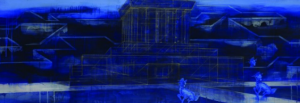 |
Galerie Quynh
65 De Tham Street,
District 1,
Ho Chi Minh City, Vietnam map *
tel: +84 8 3 836 8019
send email
website
|

Enlarge
|
| Revealed Concealed: Altered Icons
|
|
| by Galerie Quynh
Location: Galerie Quynh
Artist(s): Tuan Andrew NGUYEN, HOANG Duong Cam, Truc-Anh, Ha Manh THANG, Lien TRUONG
Date: 7 Dec 2012 - 5 Jan 2013
Galerie Quynh is pleased to present Revealed Concealed: Altered Icons, an exhibition featuring new and recent work by Ha Manh Thang (born 1980), Hoang Duong Cam (born 1974), Tuan Andrew Nguyen (born 1976), Truc-Anh (born 1983) and Lien Truong (born 1973). Through surprising depictions of various historical and contemporary figures and structures, the works in this exhibition reveal and/or conceal the shifting power, symbolism and representation of these real and fictional icons, touching on ideas of desire, truth and identity.
Hanoi-based artist Ha Manh Thang depicts the monumental edifices that symbolize Vietnam’s urban centers. Of striking and dramatic composition, his ‘Vietnam Landscapes’ pay homage to the country’s emblematic cities through iconic structures such as Ho Chi Minh’s Mausoleum, the Hue Citadel, Bitexco Financial Tower and Ben Thanh Market. Bridging modernity and tradition, Thang’s expressive style reflects domestic economic progress and development, yet the presence of two creatures suggests an ambivalence: a pink Manga-style animal coexists with Qilin (Kì Làn), the mythical Chinese entity said to appear only in areas ruled by a wise and benevolent leader. This chimerical creature seems to act like a nostalgic ghost, haunting these modern, anxious landscapes in memory of the former Vietnam.
Hoang Duong Cam’s latest photographic work ‘Self-portrait as someone who might have affected my life at a time before they began their career’ is a series of photo-collages that merge the artist’s visage with those of historical figures. In ‘Volodya 1886 – 2011’ we see the Russian revolutionary and politician Vladimir Lenin. In another photo Dang Thai Son appears, the virtuoso Vietnamese pianist and first Asian to win the International Fryderyk Chopin Piano Competition in Warsaw in 1980. Strongly impacting Vietnam’s cultural policy, Son’s achievement opened the door for future generations of artists in Vietnam. In Hoang’s work, the altering of icons by combining the personal with the public, creates a new hybrid identity: memorable faces are concealed to reveal a reconstructed portrait in the likeness of the artist. By selecting worn-out images of these illustrious figures, Hoang’s process was that of binding together fragments of his own personal history, which gradually became a restoration process of a broader history.
Tuan Andrew Nguyen’s ‘Enemy’s Enemy: A Monument to a Monument’ depicts the venerable Thich Quang Duc carved into the barrel of a Louisville Slugger baseball bat. Similar to the actual monument of Thich Quang Duc erected in Ho Chi Minh City, Nguyen’s work shows the monk calm and resolute amid engulfing flames. Referencing the monk’s self-immolation in 1963 in protest against the repression of Buddhism by the American-backed Catholic regime of Ngo Dinh Diem. As baseball is widely considered the national sport of America and the Louisville Slugger the most popular brand in the history of baseball bats, the artist poignantly touches on America’s cultural pride by carving into a national symbol the act that brought iconic status to Thich Quang Duc. Given the recent acts of self-immolation by Tibetan monks and nuns, the work resonates all the more strongly.
Heroism involves courage and Truc-Anh explores the innate antagonism within this idea by suggesting that heroes confront reality indirectly, hidden behind a mask. As public figures, icons often times assume a double identity revealing outwardly a fabricated personality while simultaneously concealing a private one. Truc-Anh’s graphite drawing depicting Batman’s lone and fractured mask represents the dual identity of the virtuous but troubled (anti-)hero, whose mask is reduced to its most simple and essential nature: black, white and the transitional greys in between. In other paintings the artist contemplates the perilous assimilation of multiple identities in political and popular figures such as Dominique Strauss-Kahn and David Bowie. Whether carefully and consciously crafted or shaped and manipulated by the media, the identities are a result of slippages between truth and fiction.
In Lien Truong’s ‘Chronicles of a Protagonist’, the California-based artist explores the relationship between modern mythical heroes and their veneration. Examining the notion of desire in how one relates to icons, the artist contemplates how they captivate and inspire. Truong proposes an anxiety regarding the inescapability of death, a universal concern that leads individuals to dream of heroes or icons. Fictional heroes in popular culture such as The Terminator or Wonder Woman appear against supernatural landscapes, and upon whom the artist imposes her own features and skin color. The artist’s assimilation with these iconic figures creates super-but-human entities and depicts the irreducible conflict between existence and the eternal wish of escaping our human condition.
© Galerie Quynh |
|
|
|
|
